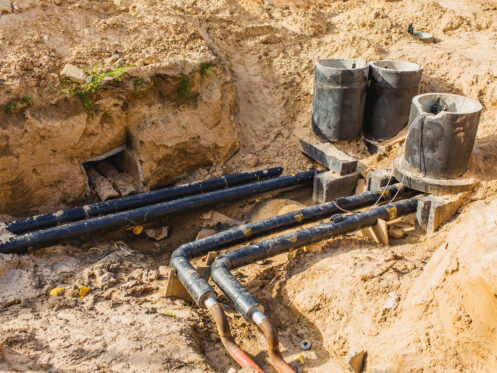In today’s world, where the consequences of human impact on the environment are becoming increasingly evident, the importance of eco-friendly practices in all sectors, including construction and infrastructure development, cannot be overstated. One such area where these practices are being implemented is installing sewer lines. Modern approaches have revolutionized this process, focusing on functionality and efficiency and reducing environmental impact.
From using advanced, less invasive technologies to recycling materials and deploying energy-efficient equipment, these practices highlight a commitment to sustainability and responsible stewardship of our planet. This commitment is manifest in every aspect of the installation process, underscoring the industry’s dedication to both environmental and regulatory compliance. Here are ways modern practices make sewer line installation eco-friendly:
1. Use of Trenchless Technology
The technology has revolutionized the process of sewer line installation by dramatically reducing environmental impact. Unlike traditional methods requiring extensive digging, trenchless methods such as pipe bursting and pipe lining require minimal excavation. This not only preserves the natural landscape but also reduces the disruption to the local ecosystem. In addition to preserving nature, trenchless technology contributes to a lower carbon footprint.
The need for heavy machinery is significantly reduced, and the project’s duration is typically shorter. This results in a substantial decrease in fuel consumption and consequent emissions. Therefore, adopting trenchless technology in the installation ensures efficiency and effectiveness and reflects a commitment to environmental sustainability and lower carbon emissions.
2. Recyclable and Sustainable Materials
Modern installations have embraced High-Density Polyethylene (HDPE), combining durability and sustainability. HDPE pipes are lightweight, which reduces fuel consumption during transportation, and their robustness ensures longevity in service, minimizing the need for replacements. Most significantly, HDPE pipes are fully recyclable. At the end of their service life, these pipes can be reprocessed and remade into new products, contributing to a circular economy and reducing waste.
Alongside this, eco-friendly sealants have become commonplace in sewer system installations. These sealants do not compromise soil and water quality, making them a safer alternative to traditional jointing materials. This measure, together with the use of HDPE pipes, underscores the industry’s commitment to using materials that are functional, efficient, and environmentally friendly.
3. Energy-Efficient Equipment
The use of energy-efficient machinery in the installation process of sewer lines is another notable advancement that contributes significantly to environmental conservation. These machines consume less fuel and produce fewer emissions, reducing the installation process’s carbon footprint. Moreover, they operate more efficiently and often have longer lifespans, reducing the frequency of machinery replacements and the associated environmental impact.
Energy-efficient machinery also reduces operational costs over time, making this a financially viable option as well. Besides reducing carbon emissions, these machines often have reduced noise levels, contributing to a less disruptive work environment. As the industry continues to prioritize sustainability, the use of energy-efficient machinery during the sewer line installation process serves as a testament to its commitment to a greener planet.
4. Green Infrastructure Integration
Incorporating green infrastructure into modern installations provides a sustainable approach to managing rainwater while benefiting the surrounding environment. An example of this is Permeable Paving. By integrating permeable surfaces in urban areas, rainwater is allowed to infiltrate the ground naturally, thus alleviating the burden on sewer systems and preventing potential overflows. This technique minimizes surface water runoff and aids in groundwater recharge, contributing to the overall water cycle.
Another key aspect of green infrastructure integration is the incorporation of Vegetated Swales. These are shallow, landscaped depressions built alongside sewer lines that capture and slowly infiltrate stormwater runoff, filtering pollutants in the process. This mechanism significantly improves water quality while also promoting groundwater recharge. The use of green infrastructure exemplifies the industry’s commitment to sustainable installations, demonstrating that functionality and eco-friendliness can work together.
5. Real-Time Monitoring and Predictive Maintenance
Advanced smart technologies are now being integrated into installations, revolutionizing the way maintenance is conducted. At the forefront of this transformation is using sensors and Internet of Things (IoT) technology. These allow for real-time monitoring of sewer conditions, providing data that can be instantly analyzed to detect anomalies or potential issues. This immediate detection significantly reduces the likelihood of environmental contamination due to unexpected breakdowns.
Equally important is the role of predictive analytics. Analyzing historical data and trends can anticipate potential maintenance needs, allowing for proactive repairs. This approach minimizes the need for emergency repairs, reducing service disruption and lowering associated environmental risks. The adoption of real-time monitoring and predictive maintenance underscores the industry’s commitment to environmental responsibility and sustainability.
6. Community Education and Participation
Community education and participation are crucial elements in the journey towards sustainable installations. Deploying smart technologies for public awareness purposes can drive impactful change. Educational campaigns are instrumental in informing communities about the importance of proper waste disposal practices and mitigating the risk of sewer line contamination. These campaigns can utilize various digital and social media platforms to ensure wide reach.
Furthermore, fostering citizen involvement in environmentally responsible sewage management practices is another key strategy. This can be achieved by offering workshops, providing interactive online resources, or launching community-based initiatives that encourage active participation. By empowering individuals with knowledge and tools, communities can significantly contribute to the sustainability of their sewer systems, thereby reinforcing the industry’s environmental commitment.
The sewer line industry is making significant strides toward sustainability, demonstrating a potent blend of modern technology, eco-friendly materials, and community participation. These advancements not only offer environmental benefits but also promise efficiency, cost-effectiveness, and a healthier planet for future generations.
In the face of these advancements, we at Drain Doctor Covina are proud to be a part of this sustainable transition. We are committed to delivering quality, environmentally-friendly sewer line installation services. For any sewer line needs or for more information on our services, feel free to contact us at (626) 332-9984. Your choice today can make a difference for our planet tomorrow.



